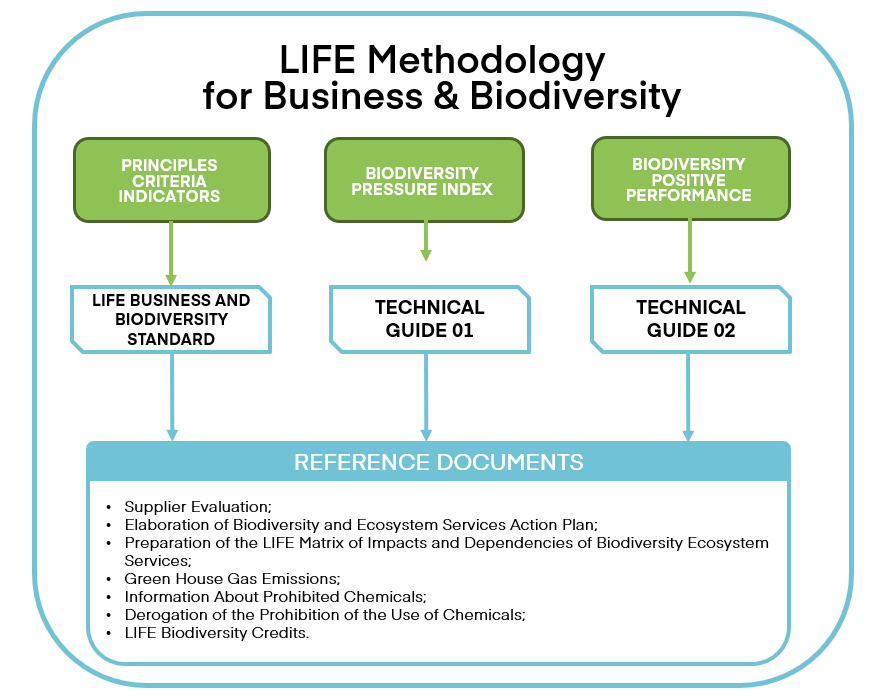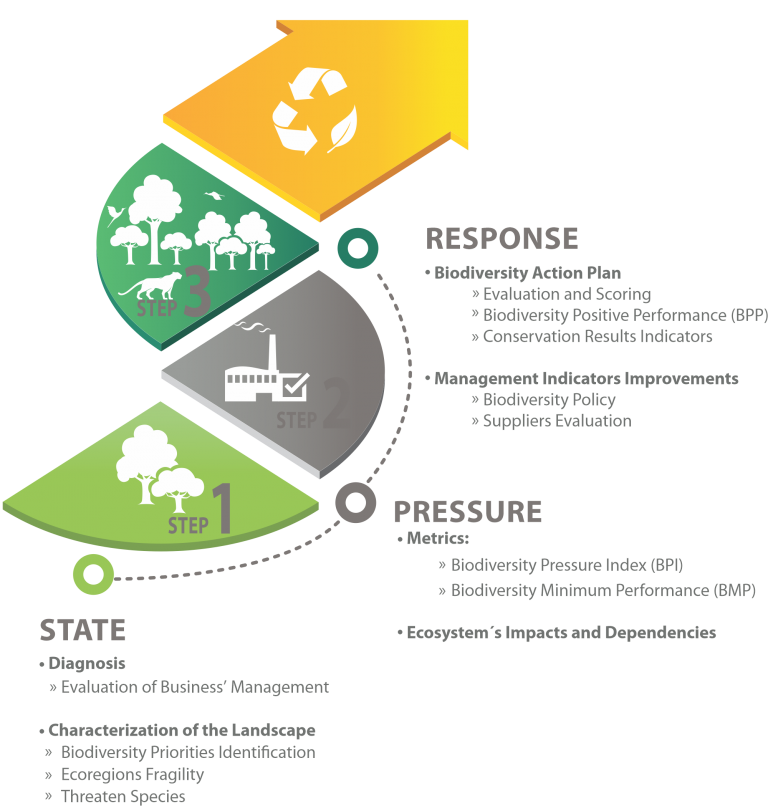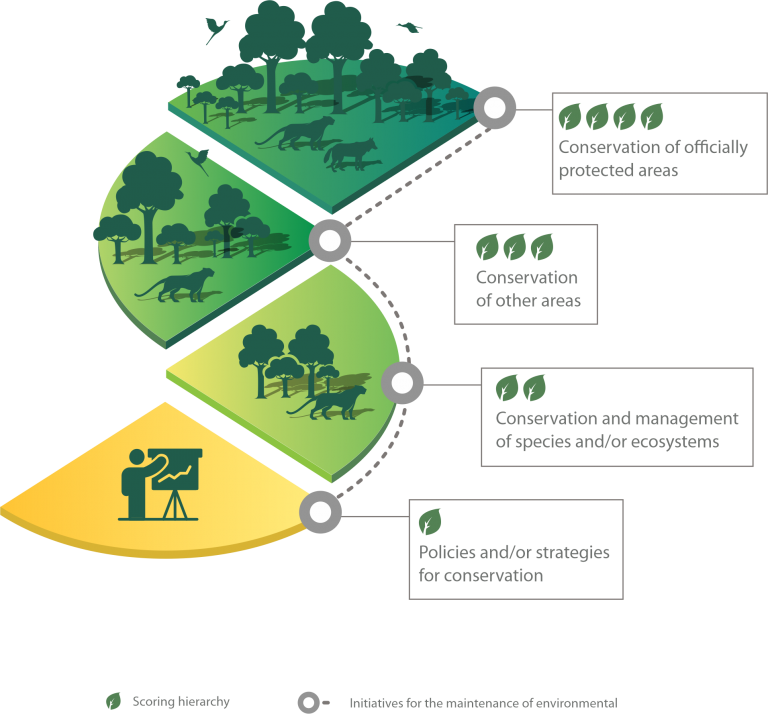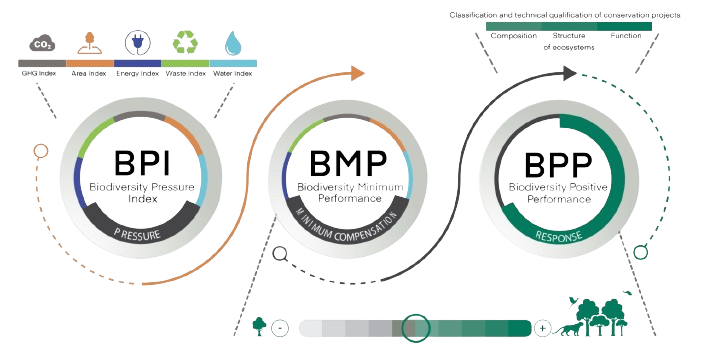LIFE METHODOLOGY FOR BUSINESS AND BIODIVERSITY
The LIFE Methodology aims to promote and recognize business engagement with biodiversity and ecosystem services. Designed to integrate biodiversity into business models, the LIFE Methodology enables the calculation of both positive and negative business impacts on biodiversity, directly contributing to Target 15 of the Global Biodiversity Framework.
The LIFE metrics developed to assess positive biodiversity impact also allow for the generation of LIFE Biodiversity Credits, which may be linked either directly to natural areas or to the organizations that manage these areas.
Applied through the LIFE Key software, it offers metrics that allow organizations to quantitatively and qualitatively assess and monitor their performance in relation to biodiversity. In this way, its application strategically guides organizations in making more effective and efficient decisions with their investments in conservation actions.
The implementation of LIFE Methodology by companies allow them to report on several corporate initiatives:
- TNFD
- Kunming-Montreal Global Biodiversity Framework (CBD/ONU): Targets 15, 18 and 19
- DJSI: Annual Corporate Sustainability Assessment (CSA) Questionnaire Biodiversity Exposure & Assessment (2.6.2)
- CDP – Climate Change 2023 Questionnaire (C15 Biodiversity)
- GRI – biodiversity related topics
- SDG – Sustainable Development Goals directly related to the integrity of biosphere, among others.
LIFE Methodology
for Business & Biodiversity
Principles
Criteria
Indicators
Biodiversity
Pressure Index
Biodiversity Positive
Performance
Reference Documents
- Supplier Evaluation
- Elaboration of Biodiversity and ecosystem services action plan
- Preparation of the LIFE matrix of impacts and dependencies of Biodiversity ecosystem services
- Green house gas emissions
- Information about prohibited chemicals
- Derogation of the prohibition of the use of chemicals
- LIFE Biodiversity credits

LIFE Documents
How LIFE Methodology Was Developed

Approximately 40% of the world economy is based on products sourced from biodiversity or its ecological processes.
All organizations, regardless of size or sector of activity, impact the ecosystem in some way, either by the use of raw materials, water and energy, by the emission of gases and waste generation, area occupation or by changes in land use.
At the same time, organizations also depend on the services provided by nature, such as the water cycle, climate regulation, supply of raw material and the regulation of air quality, for example.
Due to this dual relationship of impact and dependency, the balance and maintenance of ecosystems and the conservation of biodiversity can represent both a risk to the business and an opportunity to invest in a different strategic action. To revert the high rates of destruction of nature is an urgent necessity that should be one of the priorities in all organizations.
The methodology development process started in 2009, when a group of specialists, technicians, consultants, business managers, government officials, from the academy and from civil society worked to develop a system that considered:
- The conservation of biodiversity as a voluntary action;
- The need for a conservation performance compatible with the potential impacts to biodiversity and to investment capacity, aiming to promote the engagement of enterprises from all sectors of the economy;
- Objectivity through the quantification of impacts and rating nature conservation actions from technical and scientifically recognized criteria;
This process involved more than 50 experts and 150 organizations in public meetings, technical meetings and pilot audits, beginning from an extensive international level (Benchmarking) research on the actions already carried out on this subject.
In 2008, even before the creation of LIFE Institute, a comprehensive and extensive research was carried out in order to ensure the innovation of the mechanism to be developed, focusing on nature conservation actions, applicable to any business sector, regardless of size or field of activity of the organizations, while differentiating the performance required according to the particularities of each business.
To develop the methodology, various consultation processes to stakeholders were performed, such as: public meetings with NGOs, the academy, governments and businesses; technical meetings with various experts in the areas of environmental management and nature conservation; provision of documents and information via website; creation of a Scientific Technical Committee; and the creation of a Permanent Technical Committee.
The testing and improvement of the methodology in order to release its 1.0 Version further included in loco assessments performed in organizations of different sizes and sectors located in different biomes. These evaluations were carried out by a team with extensive experience.
How LIFE Methodology Works

The LIFE Methodology for Business and Biodiversity is an instrument that enables a clear and objective analysis of pressure, impacts (positive and negative), risks, dependencies and opportunities in business’ relationship with biodiversity.
Applied through the LIFE Key software, it offers metrics that allow organizations to quantitatively and qualitatively assess and monitor their performance in relation to biodiversity. In this way, its application strategically guides organizations in making more effective and efficient decisions with their investments in conservation actions.
LIFE Methodology for Business and Biodiversity has three interrelated steps:
With the application of the first step of the LIFE Methodology for Business and Biodiversity, organizations perform a diagnosis of their biodiversity management.
On this step, an initial assessment of the company’s management system and commercial operations is carried out. To understand the context in which the business is inserted, the landscape is characterized with the identification of the ecoregion(s), the hydrographic region, the conservation priorities and the threatened species of flora and fauna. At the same time, conservation actions already implemented by the organization are identified.
The organization’s management system is evaluated in accordance with the LIFE Standard for Business and Biodiversity, which presents Management Principles, Criteria and Indicators, applicable according to the sector and type of business operation. To access the documents of the LIFE Standard and Premises on which it was based.
The evaluation of the effectiveness of the conservation actions already implemented by the organizations follows guidelines that consider both national and international biodiversity conservation priorities and the effectiveness of the actions carried out. Information on these priorities is updated and systematized.
The scoring system for conservation actions prioritizes initiatives with greater potential for maintaining ecosystem services and conserving biodiversity in a shorter period of time.
For example, actions for the creation and protection of legally protected areas (so-called ‘Conservation Units’, in Brazil) guarantee a direct and effective return for the maintenance of ecosystems’ services, therefore, they score more than actions carried out with a focus on the protection of a single species. More details on this scoring system can be found.

In the second step, the pressure exerted by the organization’s activities is evaluated. The Biodiversity Pressure Index (BPI) is calculated, which considers environmental aspects such as energy and water consumption, waste generation, greenhouse gas emissions and land use index, considering both quantity and severity.

The BPI is an index, on a scale from 0 to 1000, which allows comparability between units within the same organization as well as between different organizations and sectors of activities.
At the same time, the impacts, dependencies, risks and opportunities of the business’ relationship with biodiversity are evaluated through the LIFE Matrix of Biodiversity and Ecosystem Services.
After collecting all this information, the methodology calculates the minimum performance required in conservation actions to compensate for the impact caused by the use of natural resources.

More information on how this calculation is done is available here.
LIFE Methodology Differentials




One of the first steps in developing the Methodology was the creation of a multidisciplinary team of specialists, biologists, mathematicians, engineers, and environmental managers, who, through a complex and integrated work, developed the LIFE methodology.